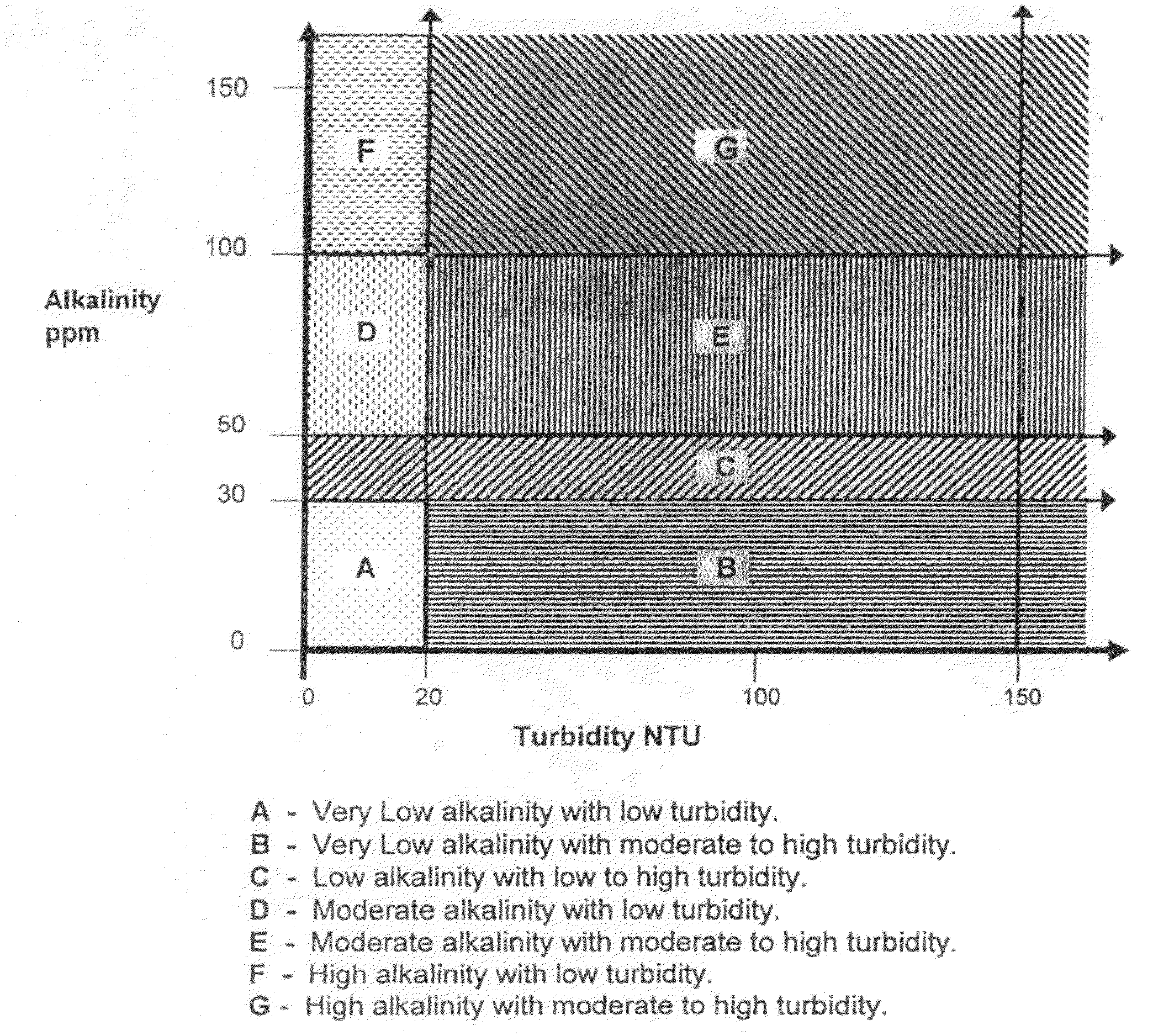Clarification of water and wastewater
a technology for water and wastewater, applied in biological water/sewage treatment, water/sewage treatment by oxidation, separation processes, etc., can solve the problems of reducing the calcium alkalinity level, and reducing the amount of raw water used in the treatment process, so as to reduce the amount of raw water used, reduce the cost of operation and operating capital, and reduce the effect of color content, turbidity
- Summary
- Abstract
- Description
- Claims
- Application Information
AI Technical Summary
Benefits of technology
Problems solved by technology
Method used
Image
Examples
example 1
[0131]In the water production facility of Bonham, Tex., aluminum sulfate, a low molecular weight DADMAC and bentonite clay are used to produce water with a turbidity ranging from about 0.1 NTU to about 0.3 NTU. The alkalinity normally is between about 10 ppm to about 20 ppm. The raw turbidity usually ranges from about 3 NTU to about 6 NTU. The chemical dosages are normally from about 40 ppm to about 60 ppm alum, about 10 ppm bentonite clay and about 20 ppm low molecular weight DADMAC.
[0132]Jar tests were performed with a poly-aluminum chloride / aluminum chlorohydrate blend of Applicant (being 50% active) and high molecular weight DADMAC of Applicant (referred to as CV 3650, having a molecular weight greater than 1 million and being 20% active), producing water with a turbidity of about 0.7 NTU without any filtration. The chemical dosages were approximately 12 ppm by volume (12 ppm×1.36 specific gravity×0.5 concentration=8.2 ppm by weight) of the 50% active poly-aluminum chloride / alum...
example 2
[0133]In the water production facility of Camden, Ark., ferric sulfate is used to produce water with a turbidity of approximately 0.1 NTU. The alkalinity is normally near 10 ppm. The raw turbidity usually ranges between about 5 to about 20 (with a turbidity of less than 20 NTU being referred to as “low turbidity” and a turbidity of greater than 20 NTU being referred to as a “moderate turbidity” herein). Chemical dosages are normally about 30 ppm to about 60 ppm iron sulfate.
[0134]Jar tests were performed with a poly-aluminum chloride / aluminum chlorohydrate blend of Applicant (being 50%) active and high molecular weight DADMAC of Applicant (referred to as CV 3650, having a molecular weight greater than 1 million and being 20% active), producing water with a turbidity at approximately 0.1 NTU without any filtration. Dosages were about 6 ppm by volume (6 ppm×1.36 specific gravity×0.5 concentration=4.1 ppm by weight) of the 50% active poly-aluminum chloride / aluminum chlorohydrate blend ...
example 3
[0136]In the water production facility of Antlers, Okla., aluminum sulfate is used alone to produce water having a turbidity ranging from about 0.1 NTU to about 0.3 NTU. The alkalinity is normally less than 10 ppm. The raw turbidity normally is between about 3 NTU to about 10 NTU. The chemical dosage of alum normally ranges between about 40 ppm to about 60 ppm.
[0137]Jar tests were performed with a poly-aluminum chloride / aluminum chlorohydrate blend of Applicant (being 50% active) and high molecular weight DADMAC of Applicant (referred to as CV 3650, having a molecular weight greater than 1 million and being 20% active), producing water with a turbidity of approximately 0.6 NTU without any filtration. The dosage of the poly-aluminum chloride / aluminum chlorohydrate blend was about 8 ppm by volume (8 ppm×1.36 specific gravity×0.5 concentration=5.4 ppm by weight) and of the high molecular weight DADMAC was about 2.5 ppm by volume (2.5 ppm×1.04 specific gravity×0.2 concentration=0.5 ppm ...
PUM
| Property | Measurement | Unit |
|---|---|---|
| concentration | aaaaa | aaaaa |
| mass ratio | aaaaa | aaaaa |
| mass ratio | aaaaa | aaaaa |
Abstract
Description
Claims
Application Information
 Login to View More
Login to View More - R&D
- Intellectual Property
- Life Sciences
- Materials
- Tech Scout
- Unparalleled Data Quality
- Higher Quality Content
- 60% Fewer Hallucinations
Browse by: Latest US Patents, China's latest patents, Technical Efficacy Thesaurus, Application Domain, Technology Topic, Popular Technical Reports.
© 2025 PatSnap. All rights reserved.Legal|Privacy policy|Modern Slavery Act Transparency Statement|Sitemap|About US| Contact US: help@patsnap.com



